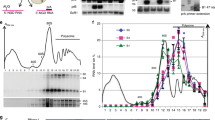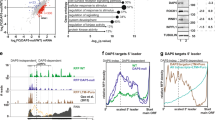Abstract
Polypeptide chain release factor eRF3 plays pivotal roles in translation termination and post-termination events including ribosome recycling and mRNA decay. It is not clear, however, if eRF3 is targeted for the regulation of gene expression. Here we show that DNA-damaging agents (UV and etoposide) induce the immediate cleavage and degradation of eRF3 in a caspase-dependent manner. The effect is selective since the binding partners of eRF3, eRF1 and PABP, and an unrelated control, GAPDH, were not affected. Point mutations of aspartate residues within overlapping DXXD motifs near the amino terminus of eRF3 prevented the appearance of the UV-induced cleavage product, identifying D32 as the major cleavage site. The cleavage and degradation occurred in a similar time-dependent manner to those of eIF4G, a previously established caspase-3 target involved in the inhibition of translation during apoptosis. siRNA-mediated knockdown of eRF3 led to inhibition of cellular protein synthesis, supporting the idea that the decrease in the amount of eRF3 caused by the caspase-mediated degradation contributes to the inhibition of translation during apoptosis. This is the first report showing that eRF3 could serve as a target in the regulation of gene expression.









Similar content being viewed by others
Abbreviations
- eIF:
-
Eukaryotic translation initiation factor
- eRF:
-
Eukaryotic translation releasing factor
- PABP:
-
Polyadenylate-binding protein
- siRNA:
-
Small interfering RNA
- PMSF:
-
Phenylmethylsulfonyl fluoride
- N-terminal:
-
Amino-terminal
- C-terminal:
-
Carboxyl-terminal
References
Morley SJ, Coldwell MJ, Clemens MJ (2005) Initiation factor modifications in the preapoptotic phase. Cell Death Differ 12:571–584
Marissen WE, Lloyd RE (1998) Eukaryotic translation initiation factor 4G is targeted for proteolytic cleavage by caspase 3 during inhibition of translation in apoptotic cells. Mol Cell Biol 18:7565–7574
Bushell M, McKendrick L, Jänicke RU, Clemens MJ, Morley SJ (1999) Caspase-3 is necessary and sufficient for cleavage of protein synthesis eukaryotic initiation factor 4G during apoptosis. FEBS Lett 451:332–336
Marissen WE, Gradi A, Sonenberg N, Lloyd RE (2000) Cleavage of eukaryotic translation initiation factor 4GII correlates with translation inhibition during apoptosis. Cell Death Differ 7:1234–1243
Bushell M, Wood W, Clemens MJ, Morley SJ (2000) Changes in integrity and association of eukaryotic protein synthesis initiation factors during apoptosis. Eur J Biochem 267:1083–1091
Bushell M, Wood W, Carpenter G, Pain VM, Morley SJ, Clemens MJ (2001) Disruption of the interaction of mammalian protein synthesis eukaryotic initiation factor 4B with the poly(A)-binding protein by caspase- and viral protease-mediated cleavages. J Biol Chem 276:23922–23928
Fraser CS, Lee JY, Mayeur GL, Bushell M, Doudna JA, Hershey JW (2004) The j-subunit of human translation initiation factor eIF3 is required for the stable binding of eIF3 and its subcomplexes to 40 S ribosomal subunits in vitro. J Biol Chem 279:8946–8956
Satoh S, Hijikata M, Handa H, Shimotohno K (1999) Caspase-mediated cleavage of eukaryotic translation initiation factor subunit 2alpha. Biochem J 342(Pt 1):65–70
Marissen WE, Guo Y, Thomas AA, Matts RL, Lloyd RE (2000) Identification of caspase 3-mediated cleavage and functional alteration of eukaryotic initiation factor 2alpha in apoptosis. J Biol Chem 275:9314–9323
Gallie DR (1998) A tale of two termini: a functional interaction between the termini of an mRNA is a prerequisite for efficient translation initiation. Gene 216:1–11
Kahvejian A, Roy G, Sonenberg N (2001) The mRNA closed-loop model: the function of PABP and PABP-interacting proteins in mRNA translation. Cold Spring Harb Symp Quant Biol 66:293–300
Preiss T, Hentze MW (1999) From factors to mechanisms: translation and translational control in eukaryotes. Curr Opin Genet Dev 9:515–521
Amrani N, Ghosh S, Mangus DA, Jacobson A (2008) Translation factors promote the formation of two states of the closed-loop mRNP. Nature 453:1276–1280
Hoshino S, Imai M, Kobayashi T, Uchida N, Katada T (1999) The eukaryotic polypeptide chain releasing factor (eRF3/GSPT) carrying the translation termination signal to the 3′-Poly(A) tail of mRNA. Direct association of erf3/GSPT with polyadenylate-binding protein. J Biol Chem 274:16677–16680
Uchida N, Hoshino S, Imataka H, Sonenberg N, Katada T (2002) A novel role of the mammalian GSPT/eRF3 associating with poly(A)-binding protein in Cap/Poly(A)-dependent translation. J Biol Chem 277:50286–50292
Marissen WE, Triyoso D, Younan P, Lloyd RE (2004) Degradation of poly(A)-binding protein in apoptotic cells and linkage to translation regulation. Apoptosis 9:67–75
Hoshino S, Imai M, Mizutani M et al (1998) Molecular cloning of a novel member of the eukaryotic polypeptide chain-releasing factors (eRF). Its identification as eRF3 interacting with eRF1. J Biol Chem 273:22254–22259
Hoshino S, Miyazawa H, Enomoto T et al (1989) A human homologue of the yeast GST1 gene codes for a GTP-binding protein and is expressed in a proliferation-dependent manner in mammalian cells. EMBO J 8:3807–3814
Jakobsen CG, Segaard TM, Jean-Jean O, Frolova L, Justesen J (2001) Identification of a novel termination release factor eRF3b expressing the eRF3 activity in vitro and in vivo. Mol Biol (Mosk) 35:672–681
Hegde R, Srinivasula SM, Datta P et al (2003) The polypeptide chain-releasing factor GSPT1/eRF3 is proteolytically processed into an IAP-binding protein. J Biol Chem 278:38699–38706
Funakoshi Y, Doi Y, Hosoda N et al (2007) Mechanism of mRNA deadenylation: evidence for a molecular interplay between translation termination factor eRF3 and mRNA deadenylases. Genes Dev 21:3135–3148
Hosoda N, Funakoshi Y, Hirasawa M et al (2011) Anti-proliferative protein Tob negatively regulates CPEB3 target by recruiting Caf1 deadenylase. EMBO J 30:1311–1323
Kroemer G, Galluzzi L, Vandenabeele P et al (2009) Classification of cell death: recommendations of the nomenclature committee on cell death 2009. Cell Death Differ 16:3–11
Cohen GM (1997) Caspases: the executioners of apoptosis. Biochem J 326(Pt 1):1–16
Deng J, Harding HP, Raught B et al (2002) Activation of GCN2 in UV-irradiated cells inhibits translation. Curr Biol 12:1279–1286
Hosoda N, Kobayashi T, Uchida N et al (2003) Translation termination factor eRF3 mediates mRNA decay through the regulation of deadenylation. J Biol Chem 278:38287–38291
Lee JA, Park JE, Lee DH et al (2008) G1 to S phase transition protein 1 induces apoptosis signal-regulating kinase 1 activation by dissociating 14-3-3 from ASK1. Oncogene 27:1297–1305
Malta-Vacas J, Aires C, Costa P et al (2005) Differential expression of the eukaryotic release factor 3 (eRF3/GSPT1) according to gastric cancer histological types. J Clin Pathol 58:621–625
De Benedetti A, Graff JR (2004) eIF-4E expression and its role in malignancies and metastases. Oncogene 23:3189–3199
Chauvin C, Jean-Jean O (2008) Proteasomal degradation of human release factor eRF3a regulates translation termination complex formation. RNA 14:240–245
Malta-Vacas J, Chauvin C, Gonçalves L et al (2009) eRF3a/GSPT1 12-GGC allele increases the susceptibility for breast cancer development. Oncol Rep 21:1551–1558
Brito M, Malta-Vacas J, Carmona B et al (2005) Polyglycine expansions in eRF3/GSPT1 are associated with gastric cancer susceptibility. Carcinogenesis 26:2046–2049
Acknowledgments
This work was supported in part by Grant-in-Aid for Scientific Research on Innovative Areas “RNA regulation” (No. 20112005) from the Ministry of Education, Culture, Sports, Science and Technology of Japan, and Grant-in-Aid for Scientific Research (B) (No. 21370080) from Japan Society for the Promotion of Science (to S H) and NIH grant AG014357 (to ESA).
Conflict of interest
The authors declare that they have no conflict of interest.
Author information
Authors and Affiliations
Corresponding author
Electronic supplementary material
Below is the link to the electronic supplementary material.
Rights and permissions
About this article
Cite this article
Hashimoto, Y., Hosoda, N., Datta, P. et al. Translation termination factor eRF3 is targeted for caspase-mediated proteolytic cleavage and degradation during DNA damage-induced apoptosis. Apoptosis 17, 1287–1299 (2012). https://doi.org/10.1007/s10495-012-0765-7
Published:
Issue Date:
DOI: https://doi.org/10.1007/s10495-012-0765-7




